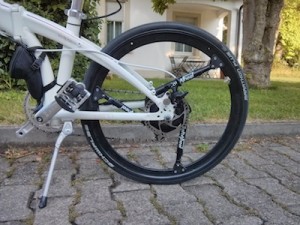The concept of SoftWheel was initially imagined as an improvement for wheelchairs, but its potential uses are numerous. (photo from SoftWheel)
While new patents and inventions appear all the time, they don’t often aim at a mainstay, like the common wheel, which has had the same design for thousands of years.
Many inventors have focused on how a wheel connects to a vehicle through different suspension systems. An Israeli startup has infused the suspension right into the wheel itself, with a selective shock absorption system.
Dubbed “SoftWheel,” the concept was imagined by Israeli farmer Gilad Wolf when, a few years ago, he broke his pelvis and was confined to a wheelchair.
“Sitting on one of the more sturdy wheelchairs, having to manoeuvre around his fields, Gilad decided to design an improved model with suspension,” said Ronny Winshtein co-founder, inventor and former chief executive officer of SoftWheel.
Wolf partnered with some colleagues and an Israeli nonprofit organization for rehabilitation technologies called Milbat and, together, they approached Tel Aviv-based Rad-Biomed Accelerator to assist in funding and developing the project.
“Rad-Biomed CEO David Zigdon liked the idea but decided to come up with a product that would be disruptive in technology and market orientation,” said Winshtein.

With Winshtein, they decided they would put the suspension in the wheel and make it selective – i.e., to work only at high-magnitude shocks – otherwise, the wheel would remain purely round and concentric, functioning like any other wheel.
In 2011, SoftWheel was founded with this notion in mind, and it attracted some of the best and brightest players in Israel to the wheel business. One of them, Ziv-Av Engineering, assisted them in developing the wheel’s unique mechanism.
“Putting suspension into the wheel has many advantages, like giving you the freedom to plug in the suspension onto any frame you like,” said Daniel Barel, SoftWheel’s current CEO. “You can just pick one out of a catalogue. As well, the suspension covers 360 degrees of incoming shocks, rather than [the] linear shocks absorbers provided in most frames.”
Barel explained why a design like theirs had not been done until now. “With promise comes challenges, and having the shocks in the frame of a flexible wheel creates design challenges for the rest of the vehicle’s frame – a challenge fairly non-existent in wheelchairs.”
The biggest problem with wheelchairs is adding suspension to the chair, as it adds weight. “Active wheelchair users commonly disconnect the wheels from the frame when getting into their car, etc., and pull the wheelchair components with a single hand from the ground to the passenger seat … so, weight becomes a major issue,” said Barel. “By adding suspension (meaning, adding some weight) to the wheels, which are always lighter than the frame, [it is easier to manoeuvre the chair portion].… On the other hand, SoftWheel understands the need to have the lightest possible wheels, so the overall wheelchair weight won’t be more than current lightweight wheelchairs.”
What makes SoftWheel’s wheel better than any other, according to Barel, is the embedded suspension. “It’s a real suspension with not only springs, but also dampers, which are needed to absorb the shock. Also, it’s selective, so, during a ride on a regular road, the hub won’t wobble within the frame, keeping more of the good propulsion energy.”
The company has filed several different patent applications for utility and design that they are confident will provide broad protection to their inventions.
Barel acknowledged it is difficult to reconsider one of the oldest possible technologies ever invented, but also exciting.
“We’re currently focused, first and foremost, on the market, with a first product for active wheelchair users … in the very near future,” said Barel. “We also made substantial progress in designing similar wheels for commuter bicycles, some of which also include a motor in the wheel hub.” The prototype is featured in the video below.
“We also develop concepts for other types of vehicles based on our know-how and technology, and have been in discussion with some very interesting players in Israel and abroad,” he added.
The company is very proud to be part of the Israeli startup Kaleidoscope. Winshtein believes that it is not by chance that so many innovative technologies have originated in Israel. He said it is embedded in the culture, the atmosphere, jokingly adding, “Probably, also [the] heat and humidity, but mostly the openness, from any level, to try and change the world for the better.
“SoftWheel has been a globally oriented company from day one, and we already have good and friendly ties with different global and national players from different market segments.”
One of the other companies that has shown interest is an aircraft landing gear manufacturer. Another focus for SoftWheel has been implementing the technology on city bikes, as more and more cities introduce bikes that anyone can pick up and return at different locations (for a cost).
“As the wheels reduce the impact of typical street blows, both wheelchairs and bikes that use them can move around freely without having to access ramps,” said Barel. “The suspension systems currently available in city bikes are unsuitable for such obstacles and often result in the rider taking the impact. Eventually, the product will sell itself and, in doing so, it has to answer real needs for real individuals.
“Like with any new concept, you do everything in your power to bring into the market the best possible product, under time and budget constraints. With time and growth, and feedback from the users, we’ll naturally be able to improve the product in different parameters, ones we already have in mind and ones we probably hadn’t thought of yet.”
Rebeca Kuropatwa is a Winnipeg freelance writer.

